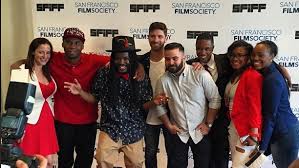Back in May of this year, I caught Romeo Is Bleeding at the SF International Film Fest. At the time, it was not only my favorite documentary of the year, but my favorite film of any genre I’ve seen in a theater in 2015.
Seeing it again last Thursday, four months later, this remains true. (Sorry, Mad Max; you’re still awesome, though, and you have decidedly more flame-shooting guitars.) But it’s striking how many things can shift from viewing to viewing. These can depend on what you bring to the film, maybe the head-space you’re in or the crowd you’re watching it with, but they can also involve what the film brings to you. Some aspects that went unnoticed (or that you downplayed in favor of others) on a first viewing seem to stand out, and others take on a different resonance.
Romeo Is Bleeding tells the story of several young poets in Richmond, CA staging a version of Romeo and Juliet, drawing on their own experiences as Black youth in a dangerous environment to rewrite, remap, and update Shakespeare’s text. The gangs, the divisions, the family tensions, the painful histories circumscribing people’s current choices, and the desperate love across borders that inform the original all find echoes in their lives, and the film places the whole endeavor in the specific contexts of a particular city at a particular moment in time. Shakespeare didn’t specifically address the environmental racism and lineages of oppression in Verona, of course, but maybe he would now.
In my original review, written directly after seeing the film screened, I focused largely on that guiding narrative. It’s easy to see why — in many ways, Romeo Is Bleeding paints on a large canvass, despite its local focus, and brings in themes of historical migration, corporate malfeasance, absent fathers in the community and by extension the prison-industrial complex, and much more. But it does this so deftly, and the central story of the play is so compelling, that it’s easy to overlook how much is going on here. On second viewing, these subtexts move into clearer view.
In particular, the film is concerned with women and girls’ experiences in ways I wish I’d drawn more attention to the first time around. Despite his humbleness on camera and low-key demeanor, Donté Clark is a towering and compelling presence in the film, and he’s Richmond’s poet laureate for a reason — he’s amazing. (His performance of a new poem last Thursday after the show, called “Somewhere in America”, removed any doubt of that, if for some reason anyone in attendance was skeptical.)
But this shouldn’t obscure the centrality of the play-within-the-film’s Juliet, D’Neise Robinson, who more than holds her own. More than any other scene this time around, I was caught speechless by an interlude where she discusses her relationship (or lack thereof) with her father, and how that comes out in her re-writing of a key moment in the play. Directly afterwards, the film gives room for a number of young women to talk about the pressures they feel specifically as young women — grappling with stereotypes of “Richmond girls” and assumptions about “down girls” who’ll hide a lover’s gun or otherwise reckon with expectations of them inside and outside their communities. The line “I don’t want to be that. I’m too pretty to go to jail” got a laugh at both screenings, but the second time came through with a melancholy and a steely determination I hadn’t picked up on the first. It would’ve been easy for the filmmakers to focus exclusively on Donté; it’s important that they didn’t, and that should be recognized.
Further, knowing what’s to come in a film frees up the viewer to notice technical aspects that can blow by in the excited rush to see what happens next. For Romeo Is Bleeding, I especially singled out the ways in which both the editing and sound design give the film texture and pace. Right out the gate, the mixing is compelling and advances the film; you feel hurtled forward, in a sort of rush of ambient sound, breathless poetry, whispers, and the unexpected “BANG” that keeps you on edge. The editing is crisp and feels extremely sure of itself, effortlessly integrating images and holding them exactly long enough to make indelible impressions.
My only second-viewing quibble — and I have to have one, that’s also a consequence of watching things more than once — was with the hand-held cinematography of the evacuation during the Chevron explosion. It must’ve been irresistible to include it, and it speaks to the frantic nature of the experience, but it also draws attention to itself in a way absolutely no other sequence does. For a movie that steadfastly avoids the charge of being “gimmicky”, this is the moment it comes closest.
But even there, it’s in service to the story. Or rather, the stories. Romeo Is Bleeding walks a narrative tightrope, and what director Jason Zeldes and his compatriots pull off is the rare film that just gets more worthwhile and admirable the closer you look. It’s currently continuing to make its rounds on the festival circuit, and you should go check it out if you can.
And then see it again, for the nuances you missed the first time around.



